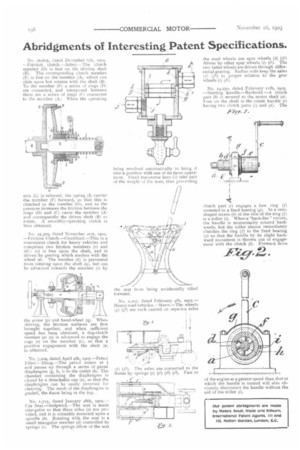Abridgments of Interesting Patent Specifications.
Page 32

If you've noticed an error in this article please click here to report it so we can fix it.
Nu. 2ti,eos, catecl December 6th, tec.4—Friction clutch.—Arbey.— The clutch member (G) is fast on the driving shaft (H). The corresponding clutch member (F) is free on the member (A), which can slide upon but rotates with the shaft (13i. To the member (F) a series of rings (Di are connected, and interposed between
these are a series of rings connected to the member (Ai. When the operating
arm (L) is released, the spring (I) carries the member (1') forward, so that this is clutched to the member (G), and as the pressure increases the friction between the rings (D) and (C) cause the member (Al and consequently the driven shaft (13) to rotate. A smoothly-operating clutch is thus obtained.
No. 25,31e, dated November sist, 1904—Friction Clutch.—Crockford.—This is a convenient clutch for heavy vehicles and comprises two friction members (c) and (d); (c) is free upon the shaft, and is driven by gearing which meshes with the wheel (el. The member (d) is prevented from rotating upon the shaft (a), but can be advanced towards the member (c) by
the screw (pi and hand-wheel (q). NSheli driving, the friction surfaces are first brought together, and when sufficient speed has been obtained, a dog-clutch member (ul (s) is advanced to engage the cogs (r) on the member (c), so that a positive engagement with the shaft (a) is obtained.
No. 7,10e, dated April 4th, 1eo5.—Petrol Filter.—Dring.—The petrol enters at j and passes up through a series of gauze diaphragms (g, h, i) to the outlet (k). The chamber containing the diaphragms is closed by a detachable cap (e), so that the diaphragms can be easily removed for cleaning. The mesh of the diaphragms is graded, the finest being at the top..
No. 1,715, dated January 28th, 5905.— Car Seat.—Sedgwick.--The seat is made triangular so that three sides (a) are provided, and it is rotatably mounted upon a spindle (b). Rotating with the seat is a small triangular member (d) controlled by springs )e). The springs allow of the seat being revolved automatically to bring it into a position with one of its faces uppermost. Fixed transverse bars (I) take part uf the weight of the user, thus preventing
the seat front being accidentally tilted forward.
No. 2,207, dated February 4th, 19o5.— Heavy road vehicles.—Mann.—The wheels (g1) are each carried on separate axles it (71). The axles are connected to the frame by springs (e) (el) (e2) (e3). Fast to the road wheels are spur wheels (h) (hi) driven by other spur wheels (i) (it). The two latter wheels are driven through differential gearing. Radius rods keep the axles if (P) in proper relation to the gear wheels (i) (11).
No. 14,25e, dated February tith, 1905. —Starting handle.—Bachtold —A clutch part (b) is secured to the motor shaft (a). Free on the shaft is the crank handle (c) having two clutch parts (e) and (d). The clutch part (e) engages a free ring (f) mounted in a fixed bearing (g). In a camshaped recess (h) at the side of the ring (f) is a roller (i). When a "back-fire" occurs, the handle is momentarily rotated backwards, but the roller almost immediately clutches the ring (f) to the fixed bearing ;Al so that the handle by its slight backward movement is thrown out of engagement with the clutch (b). Forward drive of the engine at a greater speed than that at which the handle is turned will also obviously disconnect the handle without the aid of the roller (i).
































